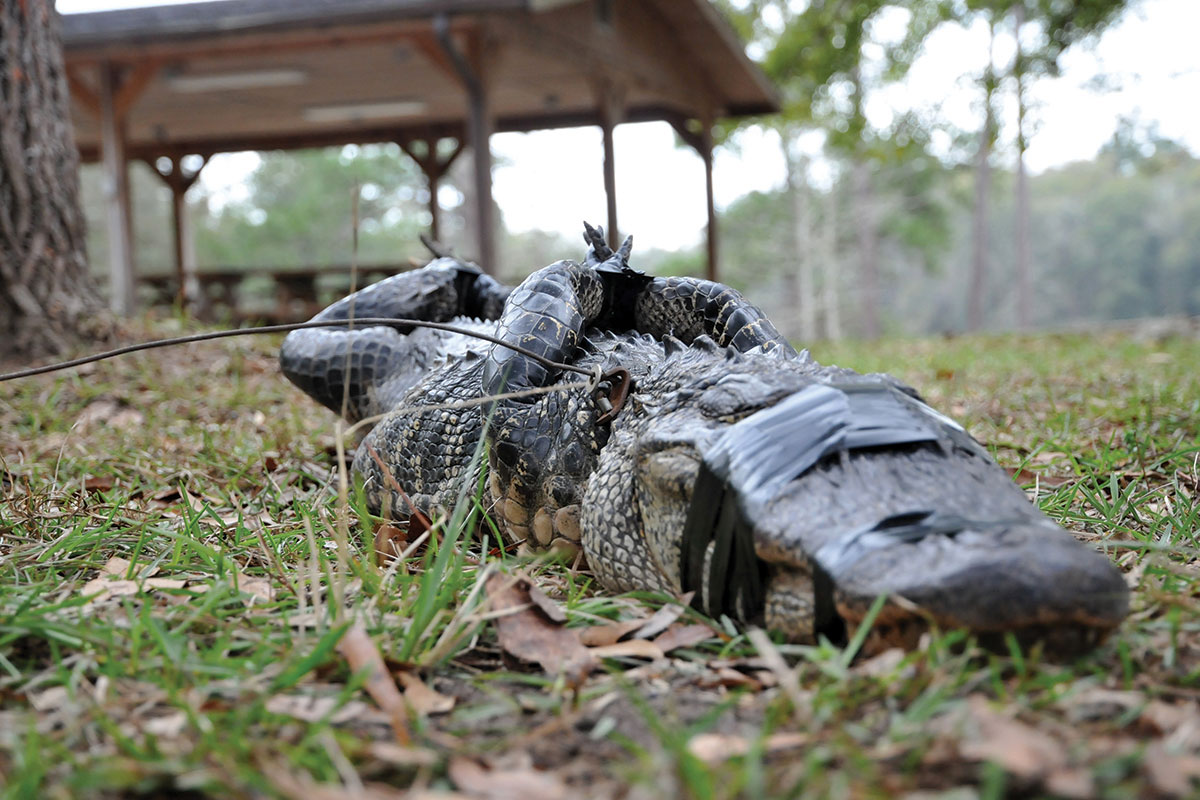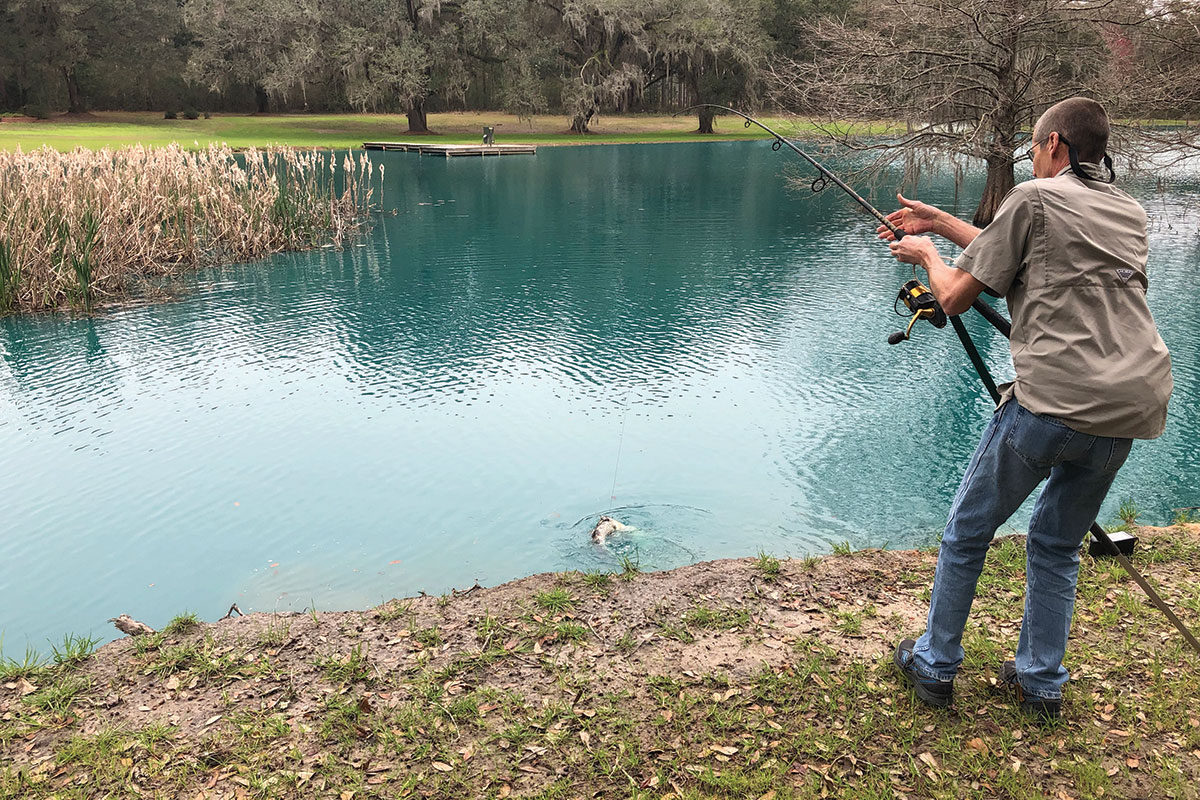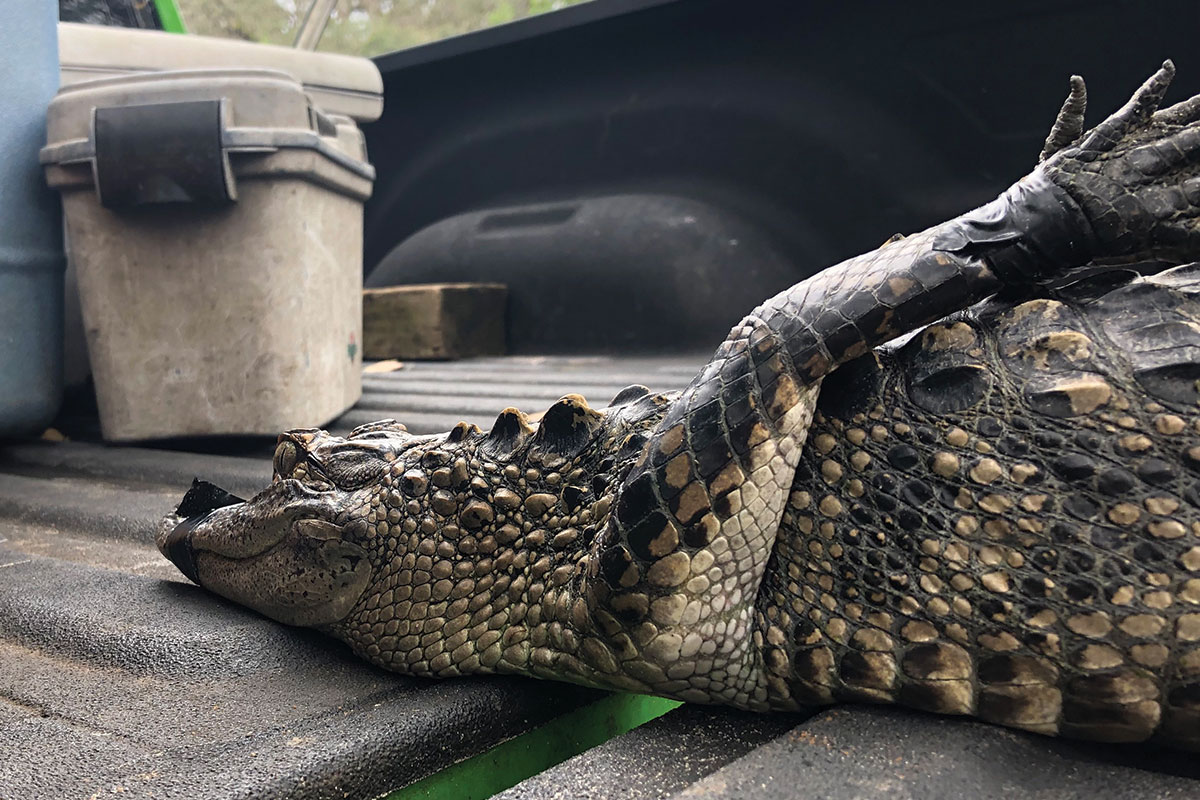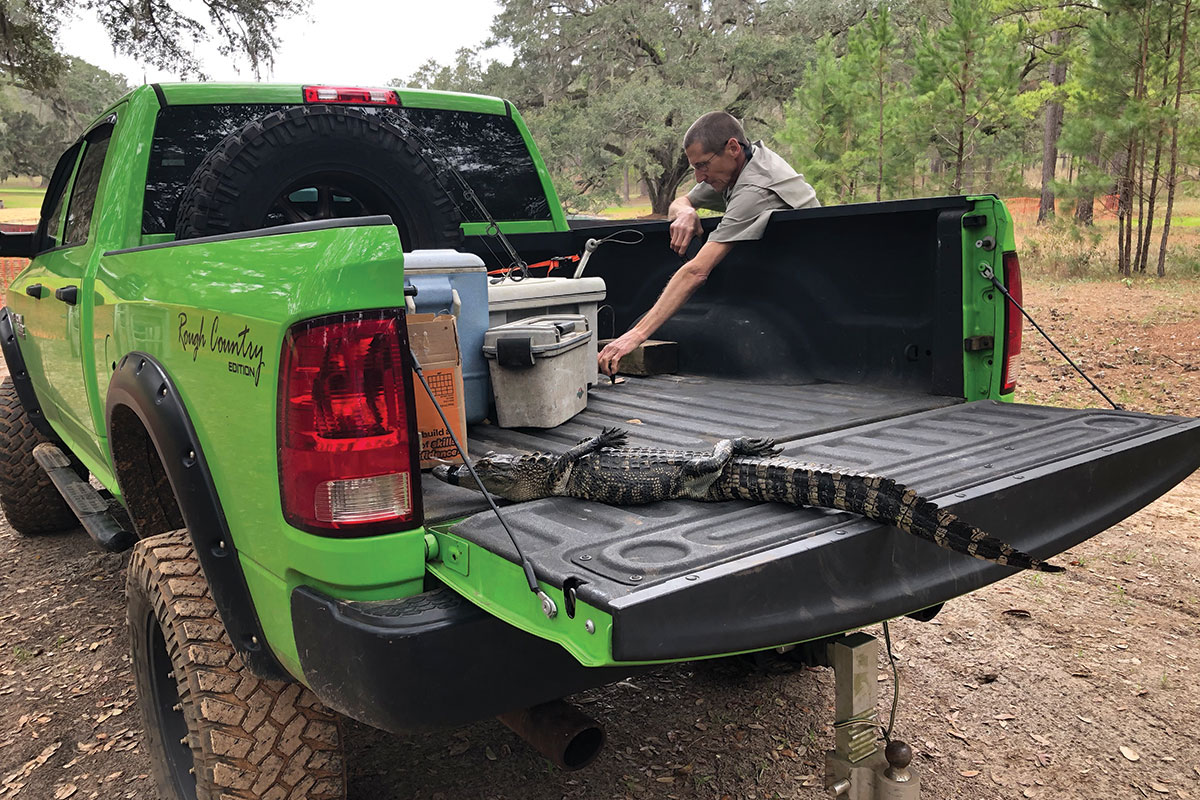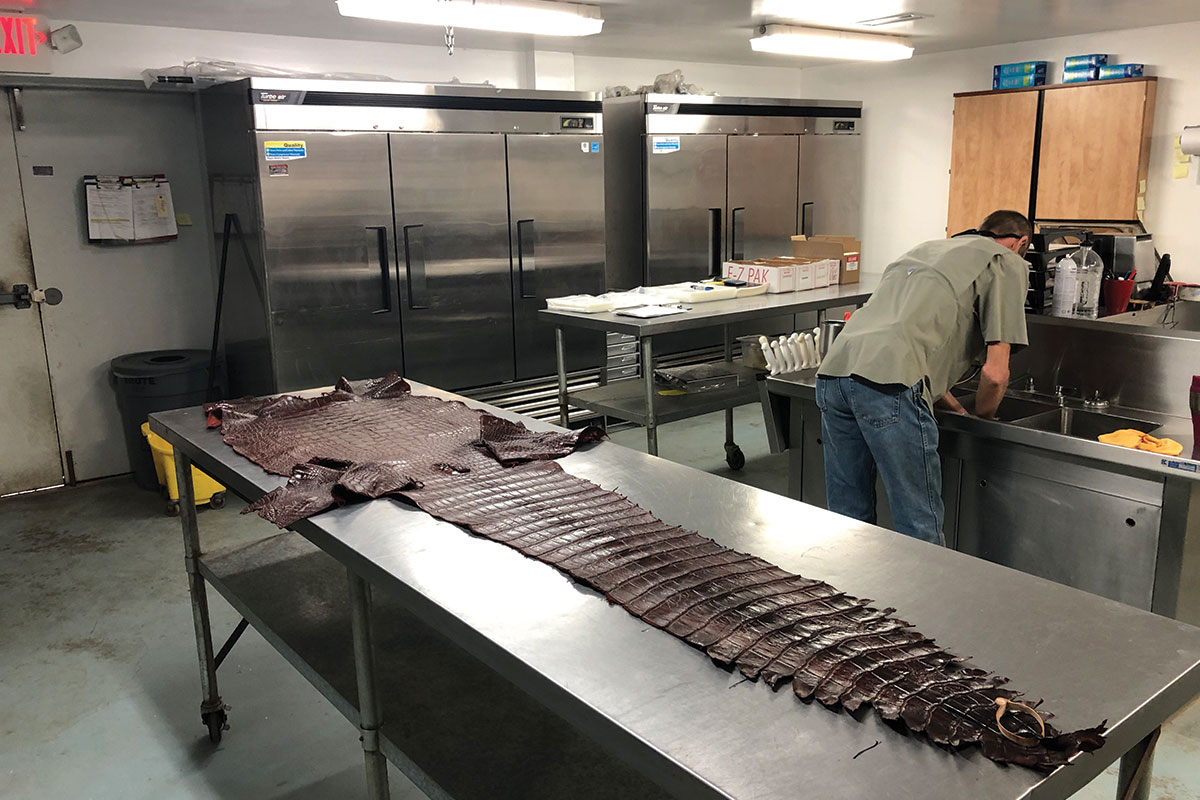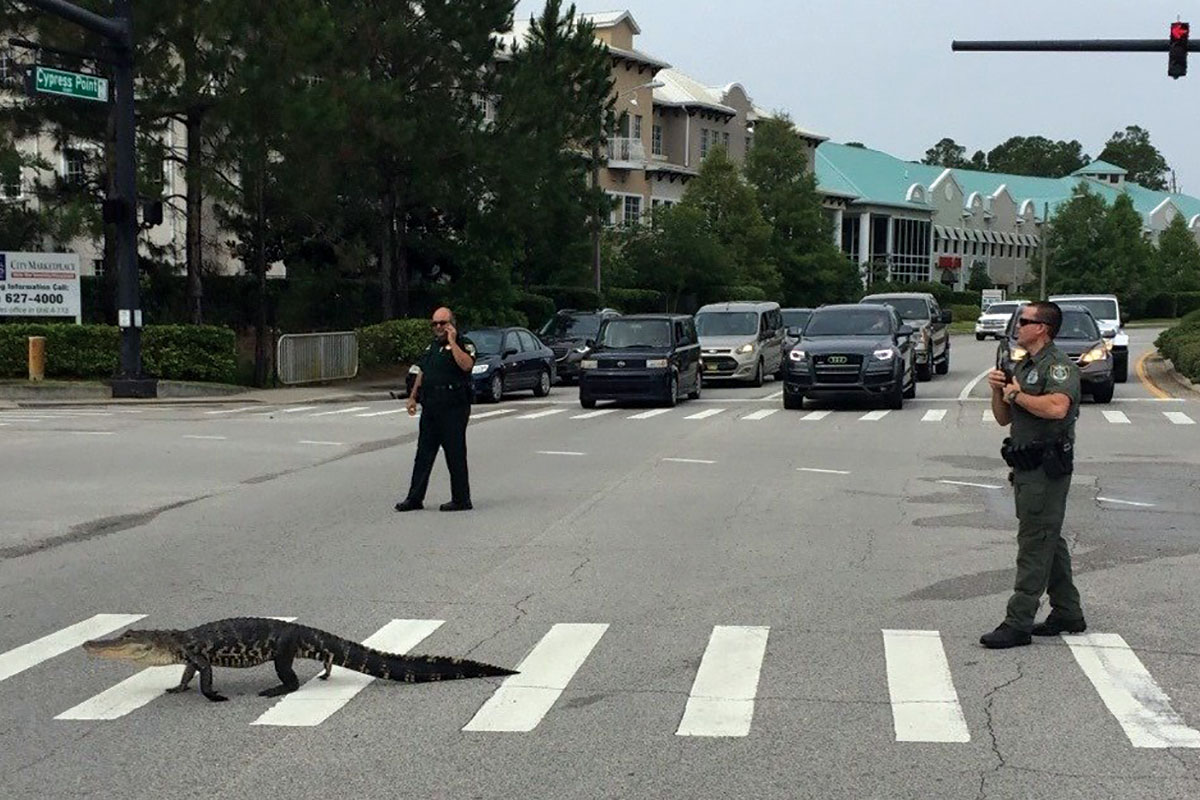“I was a roofer for 30 years,” Broderick Vaughan says. “I still have my license, but hope I never have to use it again.” We were riding in his lime green Dodge pickup truck about 20 miles northeast of Tallahassee, Florida. A few days prior, Vaughan had gotten a call from a small quail plantation owner on Old Magnolia Road, which turns to dirt, then back to pavement, and then back to dirt as you drive north, a giant live oak forming a roundabout in the middle of the red clay road at one point. Vaughan, who lives just a couple of miles away, was putting to use the other license he holds—the one that makes him a nuisance alligator trapper for the state of Florida.
The owners had called the “SNAP line”—short for the Statewide Nuisance Alligator Program hotline—to request the removal of several small alligators from a pond in front of their house. Small gators aren’t usually a threat to people, but the owners called because they were concerned for their pets. As we approached, Vaughan spotted a gator in the middle of the pond.
He pulled out a bluetooth speaker, set it on the bank, and started to play a recording of hatchling alligators making their typical high-pitched, muffled squeak. The juvenile gator immediately turned and started to swim right at Vaughan. Alligators are opportunistic feeders, and their most dangerous predators are often other alligators—hatchlings make an ideal meal for a juvenile gator. Vaughan reared back with his spinning rod, cast, and then reeled his line in right on top of the gator, snagging it with the treble hook dangling on the end of the line. The gator thrashed a few times and wriggled loose.
It took Vaughan another 20 minutes and a few more casts, but he eventually pulled the alligator onto the bank, where he secured its snout and legs with black electrical tape. It measured 3 feet, 9 inches. Nuisance trappers can keep the gators they capture and sell the hides and meat, but only if the animals measure 4 feet or longer, so later that day, he would take a ride on an airboat to release the juvenile into nearby Lake Miccosukee. His only compensation for his afternoon of work would be the $30 stipend that the Florida Fish and Wildlife Conservation Commission pays for each nuisance gator captured—at least, that should have been his compensation, but the agency had already exhausted its annual pot of money for that purpose, as it tends to do during the fourth quarter of the program year.
Today, there are approximately 1.3 million in Florida alone, and residents routinely call nuisance trappers like Vaughan to remove gators from swimming pools, neighborhood lagoons, and pretty much any other body of water they find their way into.
Vaughan grew up hunting hogs and deer in North Florida, and now that he’s hung up his roofing tool belt, he processes wild game at a facility behind his house, in addition to responding to gator complaints. He says he wishes the program were better funded, but, given how much he enjoys what he does and the fact that he’s providing a service to residents in need of help, he’s not too bothered by the afternoon of work without pay.
“I went from never harvesting a gator to getting my first one that was 10-foot-4,” he says, referencing his first alligator hunt, a few years before he became a trapper. “The second one was 11-foot-4, and then I was hooked.” In 2018, the 110 nuisance alligator trappers in Florida harvested 8,139 nuisance alligators from more than 14,000 complaints.
The laws and policies that allow gator skins and parts to be sold is an exception to how most game species are treated under the North American Model of Wildlife Conservation, which forbids sales of most wild-animal products. But the market-based system seems to be working in Florida, and it could be informative for other wildlife management challenges in the 21st century—especially ones having to do with too much, rather than too little, wildlife.
Endangered to Abundant
About half a century ago, the American alligator became one of the original endangered species. Today, there are approximately 1.3 million in Florida alone, and residents routinely call nuisance trappers like Vaughan to remove gators from swimming pools, neighborhood lagoons, and pretty much any other body of water they find their way into. For the nuisance trappers across the state, markets and commercialization are part of the foundation that helps manage this now-abundant species. So how did alligators go from endangered to nuisance status?
“The value of that hide has always been regarded as something exceptional,” says Harry Dutton, leader of the hunting and game management division of the Florida Fish and Wildlife Conservation Commission. Dutton, a wildlife biologist, explains that because those valuable hides can be used to fashion items like luxury handbags, belts, and wallets, poachers had decimated alligators by the mid–20th century. Florida outlawed gator hunting in 1961 due to the decline, and other states followed with their own bans. Later, a 1967 federal regulation deemed the species to be “threatened with extinction.” But it’s widely recognized that illegal hunting wasn’t truly curbed until 1970. That’s when the Lacey Act, which prohibits trade in wildlife products taken or transported illegally, was amended to extend its protections to reptiles.
“My biggest fear isn’t that we don’t have enough gators,” says Fish and Wildlife Conservation Commission executive director Eric Sutton, “it’s that we don’t have enough nuisance trappers.”
Soon after, poachers were convicted in several high-profile cases. With trade in reptile products stymied, the alligator population rebounded rapidly—extremely rapidly, in fact, at least in Florida. The recovery was so quick that Dutton says biologists today mostly share a consensus that there was always a strong core population of alligators in Florida, even when the species was listed as endangered. As he tells it, poachers would kill gators in easy-to-reach swamps and lakes, but the majority of wetlands were inaccessible and therefore sustained healthy and strong populations all along.
As the species recovered, its protections were gradually reduced throughout its geographic range. It was downlisted in Florida and in coastal areas of several other states in 1977. In 1987, it was declared fully recovered everywhere.
Once the species was downlisted in Florida in 1977, the state established a nuisance program to control problem gators. Subsequent changes at the federal level authorized the sale of alligator meat and export of hides, and in 1981, the state instituted experimental and limited hunts. By 1988, the year after the species was declared fully recovered, Florida authorized statewide alligator hunting. The alligator population was thriving, and the state needed to manage the numbers. With more than a million gators spread across the state today, that’s still the reality.
“My biggest fear isn’t that we don’t have enough gators,” says Fish and Wildlife Conservation Commission executive director Eric Sutton, “it’s that we don’t have enough nuisance trappers.” Capturing ornery alligators that average nearly 7 feet long is a specialized skill, to say the least. Sutton describes the state’s contracted nuisance trappers, who have to pass a background check and participate in regular reviews, as a “tremendous asset” and “an extension of the workforce” of the wildlife commission. (He notes that he considers hunters, who play an important role in helping manage wildlife, to be a similar extension of the workforce as well.)
“There are two habitats for gators in our state,” Sutton says. “Where they should be, which encompasses a lot of our landscape, and where they shouldn’t be.” A 9-foot gator in a stormwater pond in the middle of an apartment complex is a recipe for disaster, he says. “That type of incident can turn public favor against alligator conservation, which is one of our primary responsibilities.”
The nuisance program, therefore, plays a crucial part in managing the species. But with an annual budget of $210,000 for compensating trappers, and a $30 stipend per nuisance gator, the funding runs out before the alligator complaints do. That means that late in the program year, proceeds from hides, meat, and other gator parts are the only compensation trappers get—a proposition that’s largely tied to swings in the hide market. And in any event, the stipend may only cover gas money for a trapper to respond to a call, if even that.
The economic realities of these gator-trapping gigs are made clear in the state’s application: “Trappers may need to have additional employment, because being a nuisance alligator trapper may not provide sufficient income to support an individual or family.” That’s one reason the program includes an eclectic group of people. When it began back in the ’70s, some of the first nuisance trappers were reformed gator poachers, good-ole-boys who decided to go straight and narrow—and might have been missing a digit or two from their poaching days. Today, the cohort includes retired engineers and other professionals, as well as those who turned a gator-hunting hobby into a side gig.
Lane Stephens is one of the latter. A lobbyist who works a few blocks away from the state capitol in downtown Tallahassee, Stephens has the mounted head of a 14-foot gator he trapped in 2012 sitting on an end table beside his desk. He says he was hooked after going on an alligator hunt with a client more than a decade ago. He applied for the Gadsden County nuisance trapper job when it came open in 2010 thinking he would trap a couple dozen gators a year. Two years later, he ended up capturing 72 nuisance gators—including the 14-footer, the biggest he’s ever caught and not far off the state record.
“The market is horrible right now,” says Stephens, referencing the hide market. “If it weren’t for the meat sales my market would have dried up.” An expanding global supply from alligator farms in Louisiana and crocodile farms in Australia has put downward pressure on hide prices. These days, the high-end buyers like Gucci and Louis Vuitton that drive much of the market prefer farmed skins, which have fewer blemishes. Wild skins harvested by nuisance trappers or hunters generally require more time, attention, and craftsmanship to transform from tanned leather into finished products.
A few decades ago, when the market was booming, Florida wild gator hides reportedly sold for up to $35 a linear foot. Now, trappers hope their skins might fetch $7 a foot if they’re fortunate. (Stephens, who has been a nuisance trapper for less than a decade, says he once sold hides for $28.50 a linear foot but now can hardly find a bulk buyer.) Plus, Stephens explains, he and others in the sector fight the perception that “you trappers are getting rich off the hides,” as he says a state politician put it to him once. He showed the legislator his mileage logs for nuisance calls. At a cost of nearly $200 per gator, Stephens says he was much closer to breaking even than getting rich from trapping.
Alongside the nuisance alligator program is a statewide gator hunt, which is designed to help manage the population but also generates real revenue for the state. The wildlife commission issued more than 6,000 harvest permits in 2017, when roughly 6,200 alligators were killed. (Each permit allows a hunter to take two gators.) A resident permit currently costs $272 (out of state permits run to $1,022), and the statewide hunt generated about $1.8 million last year. Perhaps more of that funding could go toward compensating trappers, although any change to the stipend amount paid to trappers would be up to the state legislature, not the Fish and Wildlife Conservation Commission.
“Ten years ago when I started this,” Stephens says, “it was to help provide a needed service and have a little fun. When it becomes a job, it makes it a lot harder to get up at five or six in the morning to go get gators. If I can’t recoup my expenses selling my hides, then I might have to think about giving this up.”
Model Management
Nuisance trappers face their share of challenges with the alligator market, but the fact that trappers can sell their catch at all is an exception in the world of game animals. When Europeans first arrived to North America, they encountered a thickly forested continent teeming with wildlife. Settlers treated game like an open-access resource, with predictable results. By the 19th century, market hunting and trapping had compounded habitat loss from clearing land for agriculture and development to decimate species ranging from bison to passenger pigeons to beavers. With game populations in decline, the North American Model of Wildlife Conservation emerged with a distinct pillar: eliminating markets for game and wildlife products.
In a 21st-century context of abundance, some have started to question whether, from a wildlife management perspective, it still makes sense to shun markets.
Early conservationists and sportsmen played an influential role in developing the model. A 2012 report published by the Wildlife Society and the Boone and Crockett Club, for instance, describes actions taken by members of the New York Sportsmen’s Club: “At a time when there was limited or no government oversight on wildlife, they drafted, led efforts to enact, and enforced the first game laws directed against market hunting.” States eventually established hunting licenses, seasons, and bag limits in recognition that treating wildlife as an open-access resource was sure to lead to extirpations, if not outright extinctions. In 1900, the last known wild passenger pigeon was shot in Ohio. That was the same year that Congress passed the Lacey Act, which “effectively made market hunting illegal nationwide and remains the most powerful legal tool to combat this activity,” as the report put it.
Over the next century, the model helped recover many wildlife populations—but in some cases it might have been too successful. The deer population in North America has skyrocketed from a few hundred thousand at the beginning of the 20th century to perhaps 30 million today.
In a 21st-century context of abundance, some have started to question whether, from a wildlife management perspective, it still makes sense to shun markets. After all, there have always been salient exceptions to the no-commercialization tenet—notably when it comes to fur-bearing species such as beavers and mink. Historically, the model has permitted trappers to commercialize the valuable furs of such species.
“If the modern system of regulations and law enforcement is enough to guarantee that fur can be taken sustainably,” Chris Madson, retired from the Wyoming Game and Fish Department, has written, ”then I struggle to understand why it can’t regulate the market in other wild animals.“ Even the Wildlife Society report acknowledges that ”where overabundant game species such as white-tailed deer and Canada geese result in human-wildlife conflicts, and where the opportunities afforded sport hunters have proven inadequate to meet population goals,” regulated markets could provide incentives for ”implementing population control and mitigating conflicts.”
That’s basically the approach that Australia has taken to manage its estimated 50 million kangaroos, which damage crops, forage pastures, and destroy fairways across much of the country. Licensed cullers are permitted to hunt ’roos and sell their game products to processors and distributors. In recent years, the kangaroo market has evolved and broadened, as National Geographic recently reported: “Global brands such as Nike, Puma, and Adidas buy strong, supple ‘k-leather’ to make athletic gear. And kangaroo meat, once sold mainly as pet food, is finding its way into more and more grocery stores and high-end restaurants.” Australia sells kangaroo products to more than 50 countries and earned $29 million in exports from the animal products in 2017.
In a 2012 article in the Wildlife Society Bulletin, seven wildlife researchers proposed using “commercial deer harvest licenses” to help manage out-of-control herds in the United States. “Regulated commercial harvest would help state wildlife agencies manage overabundant populations of white-tailed deer and allow hunters to sell all or parts of harvested deer,” the researchers wrote. That’s not so different to the approach taken with kangaroos in Australia, or to alligators in Florida given that hunters can market the meat and parts from their quarry. Vaughan, the nuisance trapper and game processor, has felt the effects of a down hide market, but he also does brisk business selling alligator meat to restaurants and other buyers. Last fall, he even sold a few hundred pounds of gator sausages to Florida State University’s football stadium before the rivalry game—against the Florida Gators, naturally.
Sutton, the wildlife commission director, notes that the North American Model emerged during a different era—a time when bison were being slaughtered indiscriminately on the plains. “At some point,” he says, “when an animal has gone from protected to virtually nuisance, then the rules should change.” In Florida in the 1980s, it was clear that had to happen with alligators. Once they had recovered and been removed from the endangered species list, everyone could see that something would have to be done to control nuisance gators and manage the population. Today, perhaps wildlife managers could benefit from more experiments to help wrangle other abundant species, whether whitetail deer, geese, wild hogs, or anything else. If markets can work for alligators, kangaroos, and fur-bearing species, then surely there are other opportunities for them to improve wildlife management in the 21st century.
